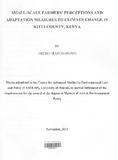| dc.description.abstract | Climate variability and change is affecting weather patterns and seasonal shifts with serious repercussions on rural households. Semi arid environments such as Kitui County, are extremely vulnerable to climate change because their production systems are climate sensitive, and large segment of the population is least able to buffer and rebound from climatic stress. Yet, there is a dearth of information on agricultural adaptation strategies embraced by farmers in this region, or whether farmers are aware of the changing climate and its impacts. To address this gap, my study assessed farmer perceptions, established coping mechanisms and examined factors influencing adaptation uptake. Such information is vital to develop optimal intervention measures that will build resilience and reduce vulnerability. Both primary and secondary data were used in this study. Primary data were collected from interviews with key informants, focus group discussions (FGDs) with farmers, and household questionnaire survey. Using semi-structured questionnaire, 332 farmers were assessed on their perceptions of climate change and how they were adapting to the impacts. The study also analysed maize crop yields in relation to rainfall over a 17 year period. Farmer perceptions were analysed in relation to meteorological data. Determinants of perceptions and adaptations were then examined using Heckman probit model and multivariate biprobit model (MVBP). Regression analysis shows that the mean annual rainfall for the area was decreasing at 34 mm per year (y = -34.272x +691.82). There was a high positive correlation between rainfall and maize yields (R=0.819, p˂0.001, n=17). Farmers’ perceptions that the region is getting drier were consistent with the rainfall data. The Heckman probit and MVBP models show that extension service, educational attainment, membership to social and economic group, and access to water were the major factors influencing adaptation uptake. Improving these factors will be important to enhance adaptive capacity at the household level. Thus, national and county governments should develop and implement integrated policies and programs that enhance farmer awareness to climate change, build local resilience, and promote transition to climate-smart agriculture. | en |

